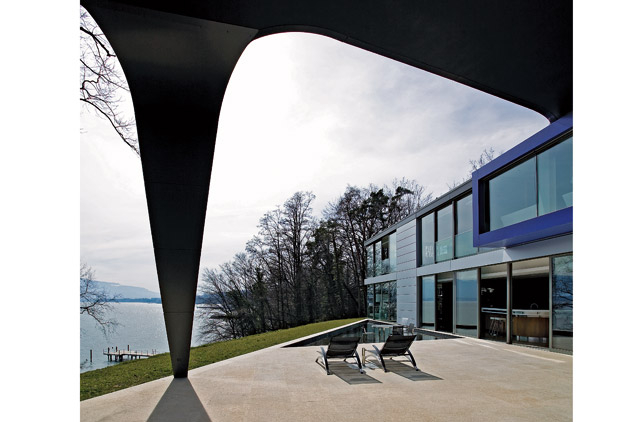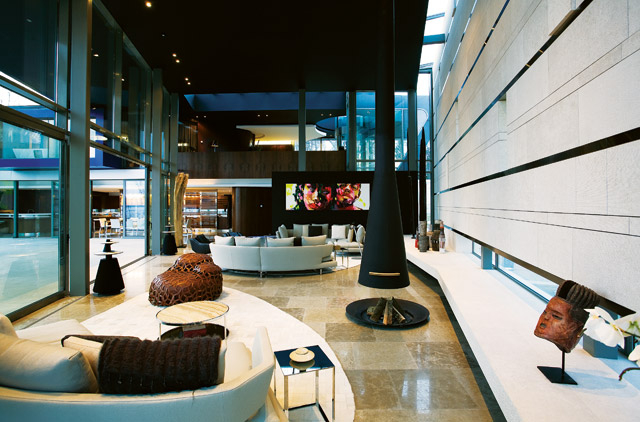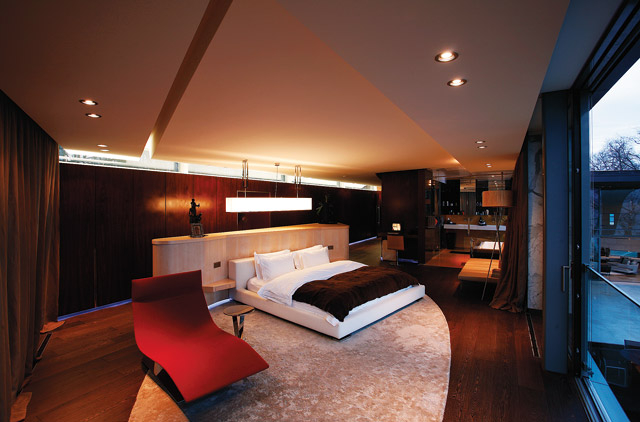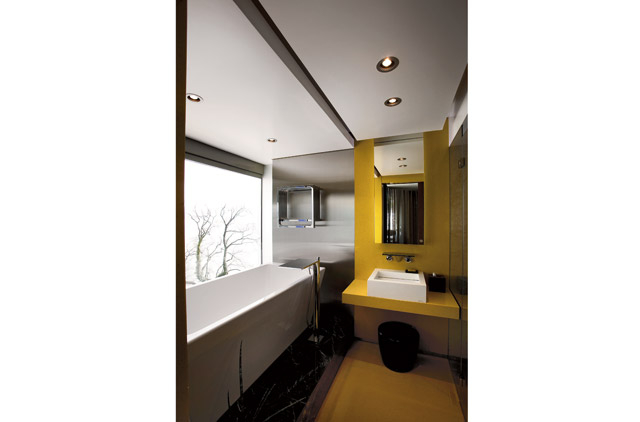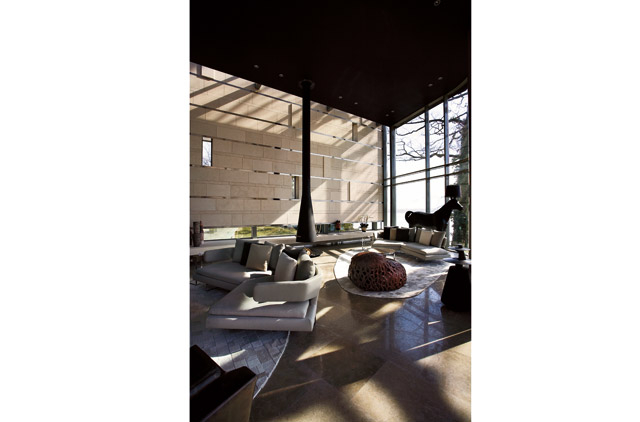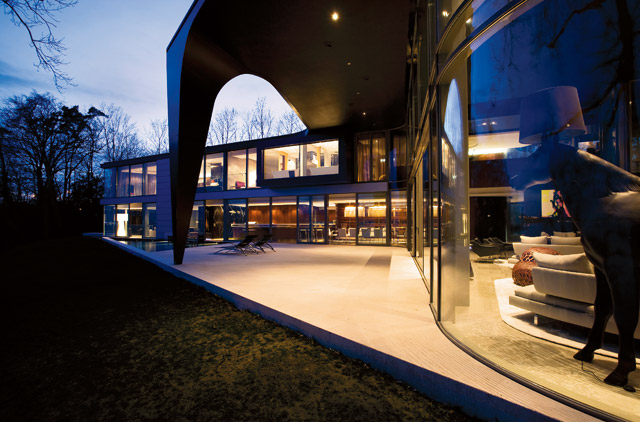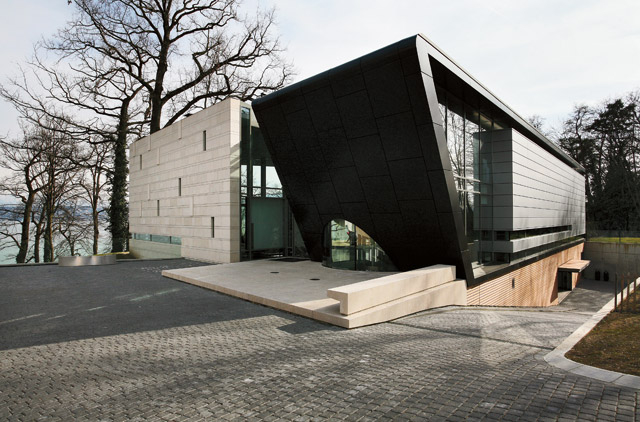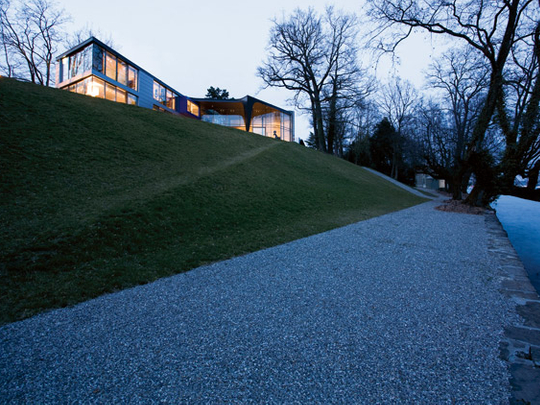
Should you ever find yourself driving alongside Lake Geneva in Switzerland, you will be forgiven for ignoring its placid waters for a few moments to gawk at a jaw dropping house along its shores; the Sow Geneva home. Designed by South African architectural firm SAOTA (Stefan Antoni Olmesdahl Truen Architects), the home is composed of a dizzying - and beautifully contradictory - array of materials, including beaten stainless steel, concrete, stone, glass and marble. It's a true contemporary surprise, especially along the shores of the somewhat conservative Lake Geneva.
Split into three levels, the shape of the 20,400 sq ft home came about as a result of the dramatic, triangular site on which it's built. "Featuring very restrictive design and building parameters, the site inspired us to come up with a reductive design that developed as a result of carving and sculpting away forms from the triangular footprint," SAOTA partner and architect Stefan Antoni explains. To make it appear less harsh, curves were introduced, adding a more streamlined look. These curves were then repeated in the interior.
SAOTA partner and architect Greg Truen describes the home - owned by a successful Senegalese businessman - as "the expression of an emerging African aesthetic in the sure way it plays with texture and materials and the way it connects to the exterior." He adds, "Conceptually, Africans have a very significant view of shelter. For Africans the roof is more essential than the vertical wall. That's all we need. But with a harsher environment, Europeans have distanced themselves from the outdoors and are used to living with more barriers between them and nature." Not at Sow Geneva. The emphasis on indoor and outdoor living is clearly achieved through the illusion of transparency; the extensive use of glass invites the outdoors in and the inside out.
Finished with different types of marble for the floors and feature walls by SAOTA, stainless steel wall cladding, glass, natural stone materials and walnut for joinery finishing, the interior décor was designed by Mark Rielly from Antoni Associates. Defined by the contemporary architectural spaces, the inside aesthetic reflects a stark modernity with subtle hints at the organic. "Because of the irregular shape of the main living spaces, furniture with rounded shapes was specifically designed and selected," Rielly explains. "An array of international contemporary branded and bespoke signature pieces, including Stefan Antoni Olmesdahl Truen Architects' OKHA brand, were specified for the project," he adds. Ethnic crafts, like African ceramics by well known South African ceramicist Louise Gelderblom and custom sized, organically shaped Nguni rugs, add an additional African element to the finished surfaces.
"Overall, the Sow Geneva home is the perfect amalgamation of African and European influences. At once both subtle and stark, it blurs the line between a variety of seemingly opposite elements," Rielly explains. We tend to agree.
Should you ever find yourself driving alongside Lake Geneva in Switzerland, you would be forgiven for ignoring its placid waters for a few moments, simply to gawk at a jaw-dropping house along its shores - the Sow Geneva home. Designed by South African architectural firm SAOTA (Stefan Antoni Olmesdahl Truen Architects), the house is composed of a dizzying - and beautifully contradictory - array of materials, including beaten stainless steel, concrete, stone, glass and marble. It's a true contemporary surprise, especially along the shores of the somewhat conservative Lake Geneva.
Split into three levels, the shape of the 20,400 square feet home came about as a result of the dramatic, triangular site on which it was built. "Featuring very restrictive design and building parameters, the site inspired us to come up with a reductive design that developed as a result of carving and sculpting away forms from the triangular footprint," SAOTA partner and architect Stefan Antoni explains. To make it appear less harsh, curves were introduced, adding a more streamlined look. These curves were then repeated in the interior.
SAOTA partner and architect Greg Truen describes the home - owned by a successful Senegalese businessman - as "the expression of an emerging African aesthetic in the sure way it plays with texture and materials and the way it connects to the exterior". He adds, "Conceptually, Africans have a very significant view of shelter. For Africans the roof is more essential than the vertical wall. That's all we need. But with a harsher environment, Europeans have distanced themselves from the outdoors and are used to living with more barriers between them and nature." Not at Sow Geneva. The emphasis on indoor and outdoor living is clearly achieved through the illusion of transparency; the extensive use of glass invites the outdoors in and the inside out.
Finished with different types of marble for the floors and feature walls, stainless steel wall cladding, glass, natural stone materials and walnut for joinery finishing, the interior décor was designed by Mark Rielly from Antoni Associates. Defined by the contemporary architectural spaces, the inside aesthetic reflects a stark modernity with subtle hints at the organic. "Because of the irregular shape of the main living spaces, furniture with rounded shapes was specifically designed and selected," Rielly explains.
"An array of international, contemporary, branded and bespoke signature pieces, including Stefan Antoni Olmesdahl Truen Architects' OKHA brand, were specified for the project," he adds. Ethnic crafts, like African ceramics by South African ceramicist Louise Gelderblom, and organically shaped Nguni rugs, add an extra African element to the finished surfaces. "Overall, this home is the perfect amalgamation of African and European influences. At once both subtle and stark, it blurs the line between a variety of seemingly opposite elements," Rielly says. We tend to agree.


